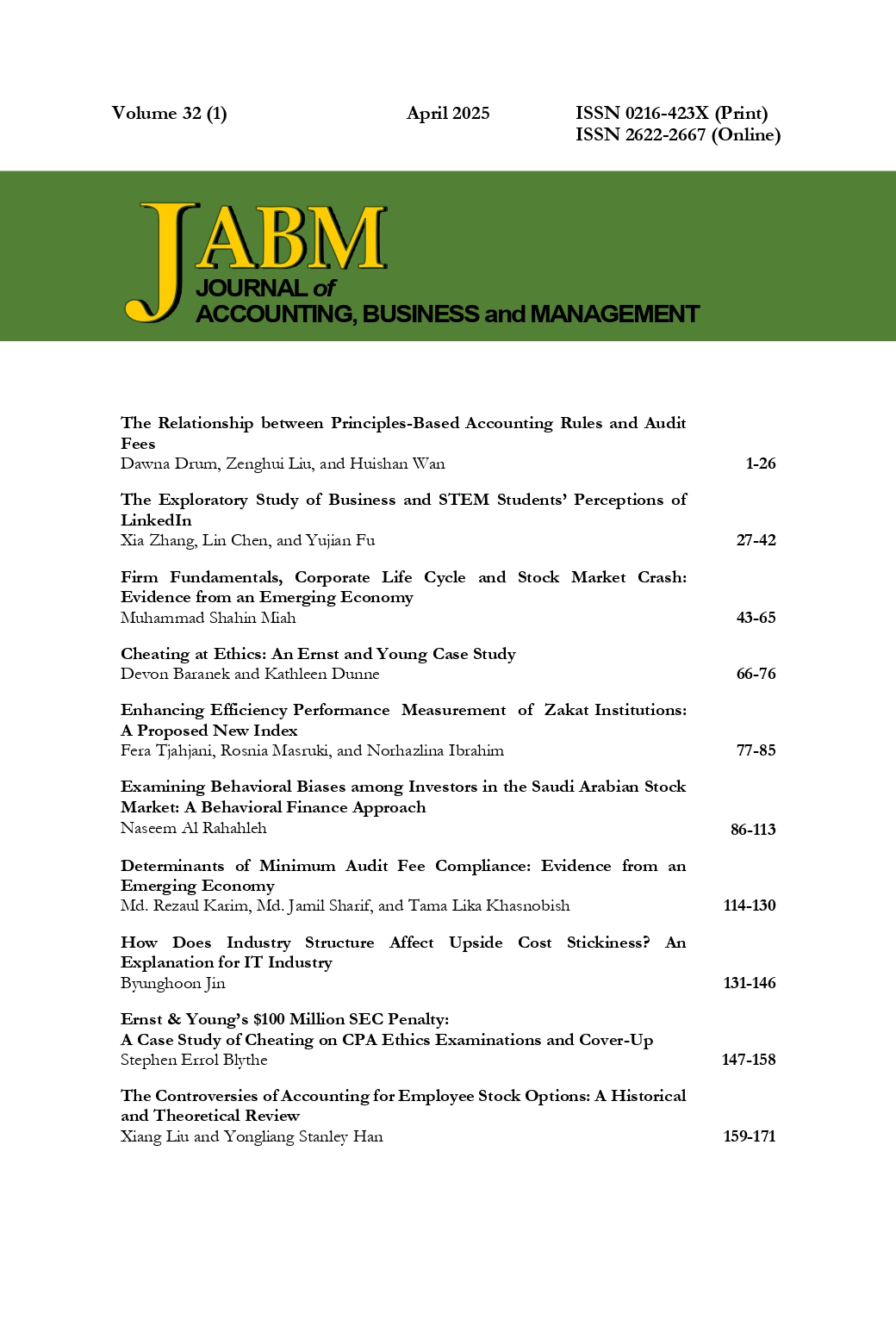Examining Behavioral Biases among Investors in the Saudi Arabian Stock Market:
A Behavioral Finance Approach
Abstract
This paper presents an explanatory study of the prevalence and influence of behavioral heuristics and prospect biases among investors in the Saudi stock market with the specific goal of determining the extent to which these biases impact investment decisions. Data were collected through an online questionnaire completed by 598 investors, and a statistical analysis was performed to determine the prevalence and impact of identified biases. The data were analyzed using descriptive statistics, and the mean values were tested using a one-sample t-test. In addition, one-way analysis of variance (ANOVA) was conducted to determine significant differences based on demographic and trading variables. The results indicate that investors in Saudi Arabia show moderate behavioral biases, with variations in how these influence investment decisions. Representativeness and regret aversion emerged as the most prominent bias, with a high level of each observed. Age, income, education, trading experience, and trading frequency were significant factors influencing. the degree of bias The findings of this study, therefore, have important implications for investors and policymakers in the KSA context, highlighting a need for initiatives that promote rational decision-making and reduce the impact of behavioral biases on investors.
Downloads
References
Argan, M., Altundal, V., & Argan, M. T. (2023). What is the role of FoMO in individual investment behavior? The relationship among FoMO, involvement, engagement, and satisfaction. Journal of East-West Business, 29(1), 69-96. https://doi.org/10.1080/10669868.2022.2141941.
Arab News. (2023, 12 Februari). Saudi bourse has 23 new companies preparing for IPO in 2023: CMA chairman. https://arab.news/5d9y6.
Barber, B. M., & Odean, T. (2000). Trading is hazardous to your wealth: The common stock investment performance of individual investors. The Journal of Finance, 55(2), 773-806.
Barberis, N., & Thaler, R. (2003). A survey of behavioral finance. In G. M. Constantinides, M. Harris, & R. M. Stulz (Eds.), Handbook of the economics of finance (1st ed., vol. 1, part B, pp. 1053-1128). Elsevier. https://doi.org/10.1016/S1574-0102(03)01027-6.
Chaffai, M., & Medhioub, I. (2014). Behavioral finance: An empirical study of the Tunisian stock market. International Journal of Economics & Financial Issues, 4(3), 527-538.
Chandra, A. (2008, 29 Desember). Decision making in the stock market: Incorporating psychology with finance. Paper presented at the National Conference on Forecasting Financial Markets of India, IIT Kharagpur, Kharagpur. https://mpra.ub.unimuenchen.de/id/eprint/21288.
Chaudhary, A. K. (2013). Impact of behavioral finance in investment decision and strategies: A fresh approach. International Journal of Management Research & Business Strategy, 2(2), 85-92.
Chitra, K., & Sreedevi, V. R. (2011). Does personality traits influence the choice of investment? IUP Journal of Behavioral Finance, 8(2), 47-57.
De Bondt, W. P. (1993). Betting on trends: Intuitive forecasts of financial risk and return. International Journal of Forecasting, 9(3), 355-371.
Dickason, Z., Ferreira, S., & Nel, I. (2017). Gender: Behavioral finance and satisfaction of life. Gender & Behaviour, 15(3), 9550-9559.
Evans, A. M., Dillon, K. D., Goldin, G., & Krueger, J. I. (2011). Trust and self-control: The moderating role of the default. Judgment & Decision Making, 6(7), 697-705.
Fahkry, B. (2016). A literature review on behavioural finance. Journal of Economics Library, 3(3), 458-465.
Fama, E. F. (1965a). Random walks in stock market prices. Financial Analysts Journal, 21(5), 55-59. https://www.jstor.org/stable/4469865.
Fama, E. F. (1965b). The behavior of stock-market prices. The Journal of Business, 38(1), 34-105. https://www.jstor.org/stable/2350752.
Fama, E. F. (1970). Efficient capital markets: A review of theory and empirical work. The Journal of Finance, 25(2), 383-417. https://doi.org/10.2307/2325486.
Kahneman, D., & Tversky, A. (1979). Prospect theory: An analysis of decision under risk. Econometrica, 47(2), 263-292. https://doi.org/10.2307/1914185.
Khan, H. H., Naz, I., Qureshi, F., & Ghafoor, A. (2017). Heuristics and stock buying decision: Evidence from Malaysian and Pakistani stock markets. Borsa Istanbul Review, 17(2), 97-110. https://doi.org/10.1016/j.bir.2016.12.002.
Kudryavtsev, A., Cohen, G., & Hon-Snir, S. (2013). “Rational” or “intuitive”: Are behavioral biases correlated across stock market investors? Contemporary Economics, 7(2), 31-53. https://doi.org/10.5709/ce.1897-9254.81.
Lin, H. -W. (2011). Elucidating rational investment decisions and behavioral biases: Evidence from the Taiwanese stock market. African Journal of Business Management, 5(5), 1630-1641.
Luong, L. P., & Thu Ha, D. T. (2011). Behavioral factors influencing individual investors’ decision-making and performance: A survey at the Ho Chi Minh stock exchange. Master Thesis, Umea School of Business, University Sweden. https://www.divaportal.org/smash/get/diva2:423263/FULLTEXT02.pdf.
Markowitz, H. (1952). Portfolio selection. The Journal of Finance, 7(1), 77-91. https://doi.org/10.2307/2975974.
Mathur, S., & Rastogi, A. (2018). Investor sentiment and asset returns: The case of Indian stock market. Afro-Asian Journal of Finance & Accounting, 8(1), 48-64. https://doi.org/10.1504/AAJFA.2018.089198.
Mittal, S. K. (2022). Behavior biases and investment decision: Theoretical and research framework. Qualitative Research in Financial Markets, 14(2), 213-228. https://doi.org/10.1108/QRFM-09-2017-0085.
Muradoǧlu, G., & Önkal, D. (1994). An exploratory analysis of portfolio managers’ probabilistic forecasts of stock prices. Journal of Forecasting, 13(7), 565-578.
Odean, T. (1999). Do investors trade too much? American Economic Review, 89(5), 1279-1298. https://faculty.haas.berkeley.edu/odean/papers%20current%20versions/doinvestors.pdf.
Pallant, J. (2020). SPSS survival manual: A step by step guide to data analysis using IBM SPSS (5th ed.). London: Routledge. https://doi.org/10.4324/9781003117445.
Parveen, S., Satti, Z. W., Subhan, Q. A., Riaz, N., Baber, S. F., & Bashir, T. (2023). Examining investors’ sentiments, behavioral biases and investment decisions during COVID-19 in the emerging stock market: A case of Pakistan stock market. Journal of Economic & Administrative Sciences, 39(3), 549-570. https://doi.org/10.1108/JEAS-08-2020-0153.
Pennings, J. M. E., & Garcia, P. (2010). Risk and hedging behavior: The role and determinants of latent heterogeneity. Journal of Financial Research, 33(4), 373-401. https://doi.org/10.1111/j.1475-6803.2010.01279.x.
Phung, A. (2010). Behavioral finance. Diambil pada 26 September 2018, dari http://i.investopedia.com/inv/pdf/tutorials/BehavioralFinance.pdf.
Podsakoff, P. M., MacKenzie, S. B., & Podsakoff, N. P. (2012). Sources of method bias in social science research and recommendations on how to control it. Annual Review of Psychology, 63(1), 539-569. https://doi.org/10.1146/annurev-psych-120710-100452.
Pompian, M. (2016, 28 Februari). Risk profiling through a behavioral finance lens. CFA Institute Research Foundation.
Pompian, M. M. (2012). Behavioral finance and wealth management: How to build optimal portfolios that account for investor biases (2nd ed.). Hoboken, New Jersey: John Wiley & Sons.
Rasheed, M. H., Rafique, A., Zahid, T., & Akhtar, M. W. (2018). Factors influencing investor’s decision making in Pakistan: Moderating the role of locus of control. Review of Behavioral Finance, 10(1), 70-87. https://doi.org/10.1108/RBF-05-2016-0028.
Ritter, J. R. (2003). Behavioral finance. Pacific-Basin Finance Journal, 11(4), 429-437. https://doi.org/10.1016/S0927-538X(03)00048-9.
Sarwar, A., Mansoor, Z., & Butt, N. S. (2014). Investor’s behavior in Pakistan mercantile exchange (PMEX). Science International, 26(3), 1371-1377.
Sekaran, U., & Bougie, R. (2019). Research methods for business: A skill building approach. Hoboken, New Jersey: John Wiley & Sons.
Sharma, A., & Kumar, A. (2019). A review paper on behavioral finance: Study of emerging trends. Qualitative Research in Financial Markets, 12(2), 137-157. https://doi.org/10.1108/QRFM-06-2017-0050.
Sharpe, W. F. (1964). Capital asset prices: A theory of market equilibrium under conditions of risk. The Journal of Finance, 19(3), 425-442. https://doi.org/10.1111/j.1540-6261.1964.tb02865.x.
Shefrin, H. (2000). Beyond greed and fear: Understanding behavioral finance and the psychology of investing. Harvard Business School Press.
Shefrin, H., & Thaler, R. H. (1988). The behavioral life‐cycle hypothesis. Economic Inquiry, 26(4), 609-643. https://doi.org/10.1111/j.1465-7295.1988.tb01520.x.
Shiller, R. J. (1999). Human behavior and the efficiency of the financial system. In Handbook of Macroeconomics (Vol. 1, pp. 1305-1340). https://doi.org/10.1016/S1574-0048(99)10033-8.
Shiller, R. J. (2000). Irrational exuberance (3rd ed.). Princeton University Press.
Singh, S. (2012). Investor irrationality and self-defeating behavior: Insights from behavioral finance. Journal of Global Business Management, 8(1), 116-122.
Sposito, V. A., Hand, M. L., & Skarpness, B. (1983). On the efficiency of using the sample kurtosis in selecting optimal lpestimators. Communications in Statistics-Simulation & Computation, 12(3), 265-272.
Szyszka, A. (2007). From the efficient market hypothesis to behavioral finance: How investors’ psychology changes the vision of financial markets. https://ssrn.com/abstract=1266862.
Tan, L., Chiang, T. C., Mason, J. R., & Nelling, E. (2008). Herding behavior in Chinese stock markets: An examination of A and B shares. Pacific-Basin Finance Journal, 16(1-2), 61-77.
Thaler, R. H. (2005). Advances in behavioral finance (Vol. II). Princeton, NJ: Princeton University Press. https://www.jstor.org/stable/j.ctt1j1nwfj.
Thaler, R. H. (2015). Misbehaving: The making of behavioral economics. New York: W. W. Norton & Company.
Tversky, A., & Kahneman, D. (1992). Advances in prospect theory: Cumulative representation of uncertainty. Journal of Risk and Uncertainty, 5(4), 297-323. https://doi.org/10.1007/BF00122574.
Waweru, N. M., Munyoki, E., & Uliana, E. O. (2008). The effects of behavioural factors in investment decision-making: A survey of institutional investors operating at the Nairobi stock exchange. International Journal of Business & Emerging Markets, 1(1), 24-41. https://doi.org/10.1504/IJBEM.2008.019243.














